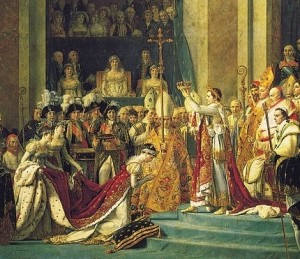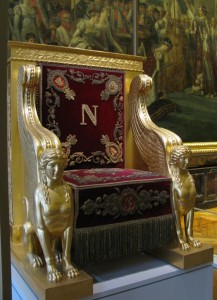
June 18, 2015—Two hundred years ago today Napoleon I (Bonaparte) was defeated at Waterloo, just south of Brussels in present-day Belgium. Waterloo at the time was neither here nor there as a destination, just a convenient place for Napoleon and 73,000 soldiers of the French Empire to try to offend the forces of the Seventh Coalition allied against his vision of Napoleonic peace in Europe before they could properly offend him.
Napoleon’s defeat at Waterloo is a major marker in European history, as is the French Revolution is. In fact, the storming of the Bastille on July 14, 1789, herald to the Revolution, and the Battle Waterloo, imminent end of the Napoleonic wars, are the bookends of an era whose heritage is visible throughout French law and society. It’s an era that historians get into fisticuffs about and that tourists are endlessly curious about, or should be.

For much of the world—except perhaps the British, proud of Wellington’s victory as an important step in their own 19th imperial dynamics—Waterloo speaks far more about the fall of Napoleon and of France’s ambitions in Europe under his leadership than it does of the victory of the forces allied against him and against France. An extended period or peace between the monarchies of Europe ensued, though within that peace were fault lines and ambitions that would eventually burst into flames, repeatedly, within and along the borders of the convenient meeting ground of Belgium.
For the American reader, few will recall that George III, routed by the American colonies and their French support three decades (Treaties of Paris and of Versailles, 1783), was still on the throne of his re-expanding kingdom in 1815. Or, more to the point, that George III’s Britain was so trigger happy after the first fall of Napoleon that they burnt Washington, DC to the ground. Or that the Congress of Vienna of 1814-1815 and the Battle of Waterloo were major steps in Prussia’s rise to power in Europe. Important history indeed. But while Napoleon lost the battle he perennially appears on the cover of The Men of Europe calendar. George III? Frederic William III? They don’t even get their birthdays mentioned. James Madison, President of the United States at the time? Who knew?

At Waterloo, Napoleon and his 73,000 men went to battle with 68,000 forces allied under the Duke of Wellington, including soldiers of the United Kingdom of Great Britain and Ireland, forces from other places where George III had friends and family, and soldiers of the United Kingdom of the Netherlands, none of whose leaders cared much for French homogeny and civil order and the threat of a French-style separation of Church and State. Field Marshal Blücher and 50,000 Prussian forces arrived in the afternoon to turn the tide of battle against the French.
Having witnessed the defeat of his strategy and the devastation of his troops (25,000 French dead and wounded) Napoleon returned wearily to Paris where he was soon forced to abdicate (June 22). He eventually surrendered himself to the British and was taken to England before being shipped off to Saint Helena in the South Atlantic to prepare his memoires. He died there in 1821 at age 51. Meanwhile, Louis XVIII was restored to the throne of France, a kingdom forced into its pre-Napoleon borders of 1790.
Waterloo led to Napoleon’s second and final abdication. His first took place on April 6, 1814, following a series of victories by the allied coalition and the occupation of a city whose name is no longer associated with Napoleonic defeat (hint: Paris). He was sent to the Isle of Elba, a small Mediterranean island between Italy and Corsica, along with his personal guard of hundreds of faithful troops. There, Emperor of Elba, he was kept abreast of happenings in Europe and state of affairs in France. Aware of the struggle in France between the heirs of the Ancien Regime and the heirs of the Revolution (Napoleon was heir to the latter) and of France’s diminished place on the world (European) stage, he felt that France couldn’t live without him and that he couldn’t live without France.

Less than a year later into his first exile, Napoleon, having gained a few pounds while on sabbatical, escaped Elba on Feb. 26, 1815 with his band of faithful guards and landed in Golfe Juan, a fishing village 12 miles east of Cannes on March 1. Over the next eight days he and his men, skirting as much as possible the royalists of Provence, he advanced north, gathering troops and other supporters along the way, particularly on the approach to Gap, where he was greeted as a savior. He arrived in Grenoble on March 8. From there, having rallied the French troops that had been sent out by Louis XVIII to arrest him, the route back to the imperial throne of France was all his. Upon his arrival in Paris on March 20, the Flight of the Eagle, as it became know, “from bell tower to bell tower until the towers of Notre-Dame,” was complete.
The route that Napoleon took from the coast to Grenoble, eventually more or less followed by National Route 85, has been labeled La Route Napoléon since 1932. Dozens of towns and villages (including Portoferraio on the Isle of Elba) along 195 miles of coastal, mountain and valley road—Cannes, Mougins, Grasse, Sisteron, Digne, Gap, Grenoble, to name the best known along the route—promote their affiliation with the emperor. They’ve naturally pulled out all the stops this year, with reenactments during the anniversary dates in March and festivities through the spring and summer. Itineraries have now been created to follow portions on foot and, for the portion from Grasse to Grenoble, on horseback.
In honor of the bicentennial of his passage through the region, one of the historic perfumers in Grasse, Galimard, has released Napoleon 1815, a new fragrance for men. The emperor was known to wear a lot of cologne, so associating the emperor with a fragrance makes sense.
 One might expect a musky, woody fragrance but what one first registers with Galimard’s Napoleon 1815 is its sweeter side, the citrus, orange blossom and rose and a hint of fig, before detecting the leather boots set beside a camp bed beneath a cedar tree on a warm day along the Mediterranean. Chantal Roux, the fragrance’s creator, says “We wanted to enter into the softer side of Napoleon.” So instead of the little corporal in kinship with his battle buddies, one encounter (or becomes) the emperor as seducer on a walk with a lady on a garden path.
One might expect a musky, woody fragrance but what one first registers with Galimard’s Napoleon 1815 is its sweeter side, the citrus, orange blossom and rose and a hint of fig, before detecting the leather boots set beside a camp bed beneath a cedar tree on a warm day along the Mediterranean. Chantal Roux, the fragrance’s creator, says “We wanted to enter into the softer side of Napoleon.” So instead of the little corporal in kinship with his battle buddies, one encounter (or becomes) the emperor as seducer on a walk with a lady on a garden path.
Galimard is a family-owned perfumer created in Grasse in 1747 by Jean de Galimard, who produced perfumes used to scent gloves—the fashion at the time—along with pomades and olive oils. Napoleon 1815 is available at Galimard’s factory-museum-boutiques in Grasse and in Eze-Village and through Galimard’s website for 65€ per 100ml atomizer. The installations in Grasse and Eze offer free tours, and at Eze visitors can take part in a brief cologne-making workshop (10€) so as to blend your own cologne. More extensive perfume initiations and workshops are available at both Grasse and Eze.
I might have written about the perfume during the bicentennial commemorations of his victorious return from exile rather on the anniversary of his momentous defeat at Waterloo. But as I said earlier, it isn’t French defeat that Waterloo represents today so much as the life and times of Napoleon himself, a powerful whiff of history that continues to pervade France.
© 2015, Gary Lee Kraut

